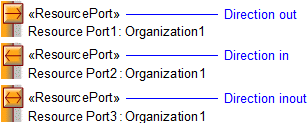Resource port (UPDM - NAF aliases)

Creation
To create a Resource Port:
• From a
Capability Configuration,
Organization,
Physical Architecture,
Post,
Resource Artifact,
Responsibility,
Service Access or
Software: right-click the element, point to New, point to NAF, and then click Resource Port.
On the Select Type dialog, create or select the element that is the type of the Resource Port, or create an untyped Resource Port.
◦ Click the  Resource Port button, and then click the diagram owner or Resource Role element that is to own the Resource Port. On the Select Type dialog, create or select the element that is the type of the Resource Port, or create an untyped Resource Port.
Resource Port button, and then click the diagram owner or Resource Role element that is to own the Resource Port. On the Select Type dialog, create or select the element that is the type of the Resource Port, or create an untyped Resource Port.
 Resource Port button, and then click the diagram owner or Resource Role element that is to own the Resource Port. On the Select Type dialog, create or select the element that is the type of the Resource Port, or create an untyped Resource Port.
Resource Port button, and then click the diagram owner or Resource Role element that is to own the Resource Port. On the Select Type dialog, create or select the element that is the type of the Resource Port, or create an untyped Resource Port.If the owner of the NSV-2 System Communications Description is not shown on the diagram, create a Resource Port on the diagram owner by clicking in free space.
◦ From an appropriate Modeler pane, locate the element that you want to use as the type of the Resource Port, and then drag that element to the edge of the diagram owner or Resource Role element on the diagram.
If the owner of the NSV-2 System Communications Description is not shown on the diagram, create a Resource Port on the diagram owner by dragging the type to free space.
The type of a Resource Port can be a
Capability Configuration,
Energy,
Exchange Element,
Geo Political Extent Type,
Materiel,
Organization,
Physical Architecture,
Post,
Resource Artifact,
Responsibility,
Service Access,
Software.
Appearance

Relationships
The following relationships are of importance to a Resource Port:
•
Resource Connector elationships link a Resource Port to other Resource Port elements.
The following sections provide information about how a Resource Port is used in the model.
Create a Resource Port from
Create from a Resource Port
Only the UPDM elements that can be created from all UPDM elements (
Alias,
Definition,
Information and
Metadata).
Shown on these diagrams, tables and matrices
In addition to the
NAV-2 Integrated Dictionary and
NTV-1 Standards Profile, which can show all UPDM elements:
UPDM writeable properties
The following writeable properties are available on the Resource Port tab of a Resource Port element's Property Pages:
• URI








